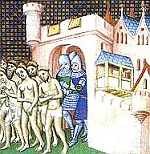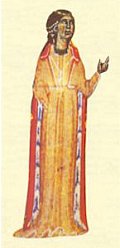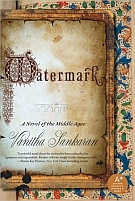HISTORICAL
FICTION
|
|

|
|
|

Cathars being expelled from Carcassonne, 1209
|
Festa
Medivale di Monselice The Art of Papermaking
Photo credit: Zyance
|

Trobaritz
|
|
BOOK
ILLUMINATIONS
From Medieval Book Reviews
|
|
Watermark

by Vanintha Sankaran

Dynamic and inspiring
In fourteenth century
France, the horrific circumstances surrounding Auda's birth mark her
inside and out. Auda stands out in a society. Her
albinoism inspires thoughts of witchery, marking a curse and marking
her as someone to be silenced. To protect her from spreading the
devil's words, her tongue is cut out and yet, Auda finds the means to
communicate, expressing herself in the art of papermaking and through
the written word. She learns to read and write, a skill many
medieval women do not have. Her father makes paper, a technology
that opens up new possibilities to those that cannot afford the expense
of parchment. Through her father's business, Auda captures
the attention of the local vicomtesse who hires her as a scribe.
In this new environment, Auda's world opens up. Ideas of the
troubadours and especially the trobaritz give her new insights and
indeed questions into love. Can a woman find true love without
becoming less? Auda meets a man who exposes her to new religious
ideas, ideas branded as dangerous. As Auda discovers the power
within herself, the forces of the Inquisition seek to root out all that
do not conform. Her growing strength becomes a danger. New
and unorthodox beliefs can lead to burning and death in this society, a
society intolerant of difference and unorthodoxy. In this
atmosphere of suspicion, fear, and violence, can Auda discover true
love and stand up for herself and her ideas, empowered by her knowledge
and hopes? Will she be able to carry on with the legacy given to
her by her father and his art?
Vanitha Sankaran's WATERMARK makes all the tensions and excitement of
the Middle Ages come alive, combining meticulous historical research
with fictional imagination. The growing middle class, the corrupt
Church and the nobility trying to protect its own power create an
exciting background for the story. WATERMARK does not simply use
history as a backdrop for her tale but rather history and papermaking
become vital, essential, fully integrated components of the
very heart of the story, the character's
lives and the narrative events. WATERMARK is an absolute
delight for the medieval enthusiast for its ability to make present the
vibrancy and dynamic tensions of the time period through a character
who challenges that world. Although she does not hesitate to show
the darker sides of the time period, Vanitha Sankaran's medieval
historical fiction elucidates the tensions and underlying pressures
that make the Middle Ages exciting and much more than the inaccurate,
stereotypical, simplistic view of the medieval times as "The Dark
Ages". Vanitha Sankaran gives voice to a richer, multi-layered,
active medieval world in which ideas and technology change and inspire
forces to counter those changes.
Within this world, Auda stands out for her
courage and sense of self. Intelligent, curious and independent,
Auda is a woman with whom modern readers can easily identify. For
feminist medievalists, Auda's fictional story gives voice to the
possible dynamics in the unrecorded lives of women. She rises
above the difficulties
she faces to strive for something more. In a world where women are
defined by others rather than their own desires, Auda makes her own
way. She
yearns for true love that will not lessen her. She yearns for a
God
who will not treat her less for being a woman. Auda investigates
the
new technology of the times. She is an active participant, not a
victim to the forces before her. Auda's story leaves a mark in
the heart of a reader. After reading WATERMARK, this medieval
enthusiast eagerly awaits her next novel, a novel set in the
Renaissance, but at the same time, I eagerly encourage her to return to
the Middle Ages as a setting in future novels because she captures
Medieval times so brilliantly in her debut novel!
WATERMARK is an excellent choice for book clubs, not only for the story
itself but also the accompanying guides. Supplemental materials
in the back include an author's note about the use of history and
fictional imagination, a glossary, a chronology of important
medieval dates, a bibliographic selection for further readings in
history and medieval literature, and an author's insight section which
includes the story behind the book, a short history of papermaking, a
recipe for papermaking, and a series of questions on 30 topics to
assist book club leaders and readers to stimulate discussion and in
depth reading of the story.
Reviewed by Merrimon,
Medieval Book Reviews

|
|